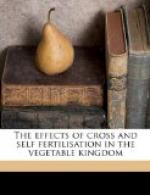Although it is probable that pollen was aboriginally the sole attraction to insects, and although many plants now exist whose flowers are frequented exclusively by pollen-devouring insects, yet the great majority secrete nectar as the chief attraction. Many years ago I suggested that primarily the saccharine matter in nectar was excreted as a waste product of chemical changes in the sap; and that when the excretion happened to occur within the envelopes of a flower, it was utilised for the important object of cross-fertilisation, being subsequently much increased in quantity and stored in various ways. (10/45. Nectar was regarded by De Candolle and Dunal as an excretion, as stated by Martinet in ‘Annal des Sc. Nat.’ 1872 tome 14 page 211.) This view is rendered probable by the leaves of some trees excreting, under certain climatic conditions, without the aid of special glands, a saccharine fluid, often called honey-dew. This is the case with the leaves of the lime; for although some authors have disputed the fact, a most capable judge, Dr. Maxwell Masters, informs me that, after having heard the discussions on this subject before the Horticultural Society, he feels no doubt on this head. The leaves, as well as the cut stems, of the manna ash (Fraxinus ornus) secrete in a like manner saccharine matter. (10/46. ‘Gardeners’ Chronicle’ 1876 page 242.) According to Treviranus, so do the upper surfaces of the leaves of Carduus arctioides during hot weather. Many analogous facts could be given. (10/47. Kurr ‘Untersuchungen uber die Bedeutung der Nektarien’ 1833 page 115.) There are, however, a considerable number of plants which bear small glands on their leaves, petioles, phyllodia, stipules, bracteae, or flower peduncles, or on the outside of their calyx, and these glands secrete minute drops of a sweet fluid, which is eagerly sought by sugar-loving insects, such as ants, hive-bees, and wasps. (10/48. A large number of cases are given by Delpino in the ‘Bulletino Entomologico’ Anno 6 1874. To these may be added those given in my text, as well as the excretion of saccharine matter from the calyx of two species of Iris, and from the bracteae of certain Orchideae: see Kurr ‘Bedeutung der Nektarien’ 1833 pages 25, 28. Belt ‘Nicaragua’ page 224, also refers to a similar excretion by many epiphytal orchids and passion-flowers. Mr. Rodgers has seen much nectar secreted from the bases of the flower-peduncles of Vanilla. Link says that the only example of a hypopetalous nectary known to him is externally at the base of the flowers of Chironia decussata: see ‘Reports on Botany, Ray Society’ 1846 page 355. An important memoir bearing on this subject has lately appeared by Reinke ’Gottingen Nachrichten’ 1873 page 825, who shows that in many plants the tips of the serrations on the leaves in the bud bear glands which secrete only at a very early age, and which have the same morphological structure as true nectar-secreting glands. He further shows that the nectar-secreting




